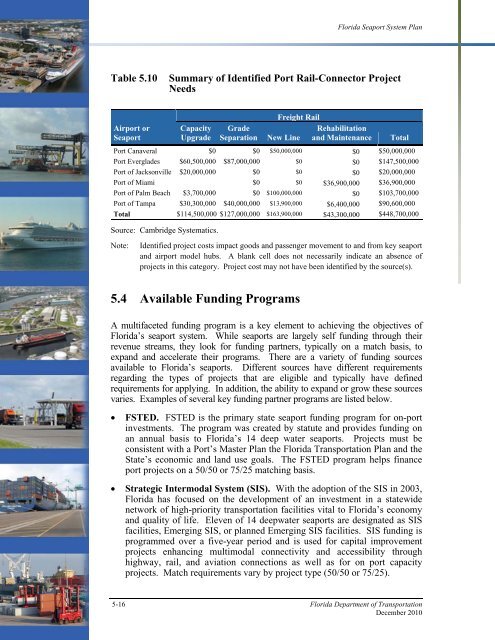Florida Seaport System Plan - SeaCIP
Florida Seaport System Plan - SeaCIP
Florida Seaport System Plan - SeaCIP
Create successful ePaper yourself
Turn your PDF publications into a flip-book with our unique Google optimized e-Paper software.
<strong>Florida</strong> <strong>Seaport</strong> <strong>System</strong> <strong>Plan</strong><br />
Table 5.10<br />
Summary of Identified Port Rail-Connector Project<br />
Needs<br />
Airport or<br />
<strong>Seaport</strong><br />
Capacity<br />
Upgrade<br />
Grade<br />
Separation<br />
Freight Rail<br />
Rehabilitation<br />
New Line and Maintenance<br />
Total<br />
Port Canaveral $0 $0 $50,000,000 $0 $50,000,000<br />
Port Everglades $60,500,000 $87,000,000 $0 $0 $147,500,000<br />
Port of Jacksonville $20,000,000 $0 $0 $0 $20,000,000<br />
Port of Miami $0 $0 $36,900,000 $36,900,000<br />
Port of Palm Beach $3,700,000 $0 $100,000,000 $0 $103,700,000<br />
Port of Tampa $30,300,000 $40,000,000 $13,900,000 $6,400,000 $90,600,000<br />
Total $114,500,000 $127,000,000 $163,900,000 $43,300,000 $448,700,000<br />
Source: Cambridge <strong>System</strong>atics.<br />
Note:<br />
Identified project costs impact goods and passenger movement to and from key seaport<br />
and airport model hubs. A blank cell does not necessarily indicate an absence of<br />
projects in this category. Project cost may not have been identified by the source(s).<br />
5.4 Available Funding Programs<br />
A multifaceted funding program is a key element to achieving the objectives of<br />
<strong>Florida</strong>’s seaport system. While seaports are largely self funding through their<br />
revenue streams, they look for funding partners, typically on a match basis, to<br />
expand and accelerate their programs. There are a variety of funding sources<br />
available to <strong>Florida</strong>’s seaports. Different sources have different requirements<br />
regarding the types of projects that are eligible and typically have defined<br />
requirements for applying. In addition, the ability to expand or grow these sources<br />
varies. Examples of several key funding partner programs are listed below.<br />
• FSTED. FSTED is the primary state seaport funding program for on-port<br />
investments. The program was created by statute and provides funding on<br />
an annual basis to <strong>Florida</strong>’s 14 deep water seaports. Projects must be<br />
consistent with a Port’s Master <strong>Plan</strong> the <strong>Florida</strong> Transportation <strong>Plan</strong> and the<br />
State’s economic and land use goals. The FSTED program helps finance<br />
port projects on a 50/50 or 75/25 matching basis.<br />
• Strategic Intermodal <strong>System</strong> (SIS). With the adoption of the SIS in 2003,<br />
<strong>Florida</strong> has focused on the development of an investment in a statewide<br />
network of high-priority transportation facilities vital to <strong>Florida</strong>’s economy<br />
and quality of life. Eleven of 14 deepwater seaports are designated as SIS<br />
facilities, Emerging SIS, or planned Emerging SIS facilities. SIS funding is<br />
programmed over a five-year period and is used for capital improvement<br />
projects enhancing multimodal connectivity and accessibility through<br />
highway, rail, and aviation connections as well as for on port capacity<br />
projects. Match requirements vary by project type (50/50 or 75/25).<br />
5-16 <strong>Florida</strong> Department of Transportation<br />
December 2010
















